Cassiar - The Product & Ron Johnson's Shake 'N Bake Chicken
Wednesday, February 07, 2007
 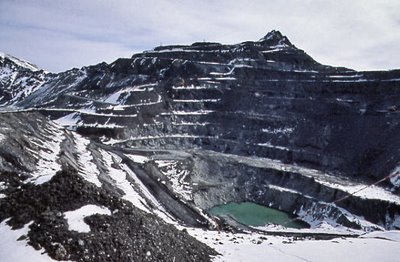 As an artist/teacher for the Emily Carr College Of Art Outreach Program (that was the name of Emily Carr Institute of Art and Design then) for 13 years in the 80s and 90s I went to teach photography in BC's interior. I visited many communities but perhaps one of the most interesting was Cassiar where I went in the middle 80s and then again in 1991, a year before the mine closed and the town became a ghost. The first time around the town and mine were thriving. They mined "product" and only when pressed was the word asbestos uttered in whispers. In the prosperity of the time (it seemd that the Japanese used asbestos for drum brake linings) the town had a company cafeteria that served some of the best food and most delicious home-baked bread I have ever had in my life. 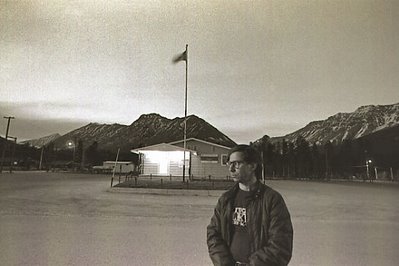 I quickly realized that besides satellite TV (soaps were most popular), the most active passtime was going after someone else's partner, taking advantage of the mine's shift system. Driving in and out of town there was a huge, ugly mountain that was not a mountain at all but simply a pile of mine tailings. I was given a tour of the mine, which was thousands of feet above sea level, and then when one got there, one descended into what for me resembled a freezing hell that Dante could have never imagined. The equipment, which had to operate in minus 40 Celsius, was all electric. The big tractors and excavators had long, thick power cords that had to be man-handled by workers who had to work all bundled as they had no heated cabs to protect them. I returned to watch a night shift. Those miners deserved every penny they earned. To get to Cassiar I had to drive from the Watson Lake, Yukon Territory airport in what was mostly (then) a gravel road. When driving on it I noticed I had two options. One of them was to drive safely and have every truck around pass me, blind me with enormous clouds of dust and then spray my incredibly cracked windshield with gravel. The second option was the one I ultimately chose. This was to drive as fast and recklessly as possible and make others bite the dust. 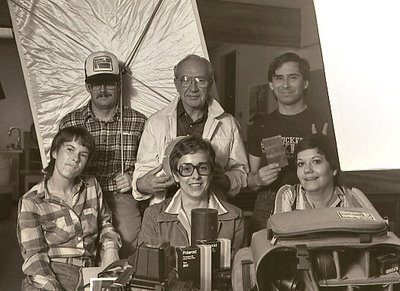 It was in Cassiar that I saw for the first time and for several nights the beautiful Aurora Borealis. At right I am posing with my class and above it's a self portrait by the Cassiar post office. I took the picture at midnight using a technique called extended range night photography. The second time around in 1991 (I arrived on Friday night) I had the worry that no matter what the weather did I had to be at the Watson Lake airport on that Monday morning. I had to be in Vancouver by noon to photograph the person who was seen as the second most important man in BC. Ron Johnson was organizing Mike Harcourt's and the NDP's bid to wrest away the province from the Social Credit Party. I was to photograph Johnson for Equity's series of important shakers in Vancouver called the Power Elite. I was instructed to take a candid photo of Johnson at home. After teaching Saturday and Sunday, a massive snowfall blanketed Cassiar and my terrible motel (it was called The Last Chance) was buried up to the windows. I knew I had to try to get to Watson Lake, no matter what. The only advantage I seemed to have (even though my students thought I had little chance of success) was that my rental car was a new-fangled front-wheel-drive Ford Taurus. I made it by never applying using my brakes and using the car's momentum to carry me over deep drifts of snow on the highway. When I gassed up at the Watson Lake gas station I was approached by many asking me about the road conditions. The fingers in my hand were throbbing . I had been holding on to that steering wheel for dear life. It began to snow and the airport attendant told me he did not think the small airplane coming from Vancouver would be able to land. But it did. As I was looking through the window I noticed a woman stepped down from the airplane. I mentioned to the man that the plane was small but it still had a flight attendant. I remember him telling me with a smirk, "Sonny, that there is your pilot and you better pray that she decides to take off in this weather or you will miss that job with that Ron Johnson guy you were telling me about." The plane's wings had to be de-iced several times and we took off. 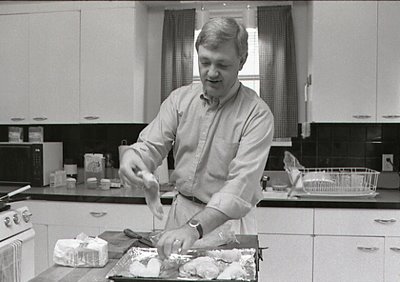 A few hours later I photographed a cool Ron Johnson making Shake 'N Bake chicken.
Jim Byrnes - God Exists
Tuesday, February 06, 2007
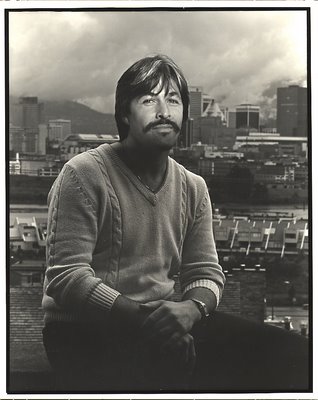 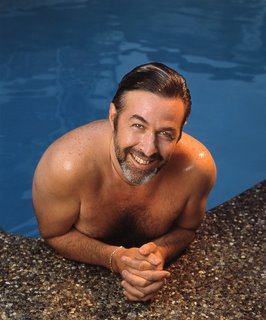 Sometimes when I dwell on finding an explanation as to why Art Bergmann isn't alive and well, rich, famous, and living in a farm in Alberta, I despair and think that God does not exist. But he does (or must) as Art Bergmann while not famous and rich is alive (many would have wagered against that) and well and living in a farm in Alberta. Now Jim Byrnes, whom I have known almost as long as Art Bergmann (the b+w photo here is of Byrnes on July 1981) is ample proof that there is some sort of heavenly justice and that God exists. He keeps winning awards (the latest including three nominations and one award for best contemporary Canadian folk singer in 2006) for his songs and his singing, he can act and I am sure he also does windows. I remember him fondly but best in the one time we met where I did not take his photograph. We ran into each other at Birks in Oakridge around 1997. He said, "How's Rosemary and how are Ale and Hilary (my daughters)? Are you still living on Athlone Street?" In March of 1989 I had to find an outdoor swimming pool in Vancouver (it ended up being in West Vancouver) to photograph Byrnes for TV Guide. I remember his uncommon patience with all the discomforts of posing for me in a bitterly cold but sunny day. I can safely say that I have never had to regret not practicing the advice that Les Wiseman gave me on Jim Byrnes. "Alex, Jim Byrnes is the kind of guy you never introduce to a woman you love. They will all fall for him." Byrnes is the perfect gentleman and Vancouver and Canada should be proud to have him here. Technical information. Some may note the odd but dramatic lighting of the b+w photograph. This is due to my unfortunate use of 1/125 of second shutter speed with the cloth focal plane shutter of my Pentax Spotmatic F. My on camera flash failed to sychronize from the top to the bottom of the frame. Had I held the camera differently (I am not consistent in this) the fortunate mistake would have been lethal and his face would have been dark. Perhaps Byrnes's God was helping me just a bit.
Virginia McKendry - Art Bergmann & Gore Vidal's Messiah
Monday, February 05, 2007
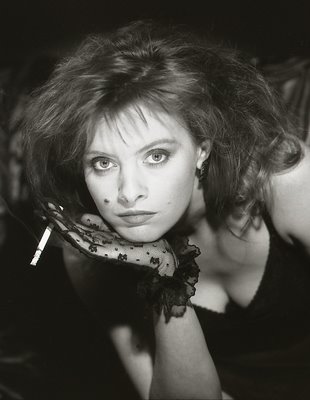
With Les Wiseman I followed the alternative music scene in Vancouver in the 80s and into the early 90s when it all but disappeared. In those years taking pictures of a band in my studio was a chore. The band members would arrive late, some would not show up. Others would arrive drunk or high on drugs. It was a job that I soon abandoned for boring but predictable ones.
I always went to any concert by Art Bergmann, our very own Johnny Thunders. There was always brilliance and virtuosity even if for a few minutes. But his passion (when he played his guitar) was full-time. Interesting people went to Art Bergmann concerts. A few were junkies and others lived with them. But all were gentle and always treated me with respect. I remember taking my daughter Ale to several Bergmann concerts and I even took her to recording sessions in underground studios. Ale came to appreciate what I saw in Art Bergmann's music.
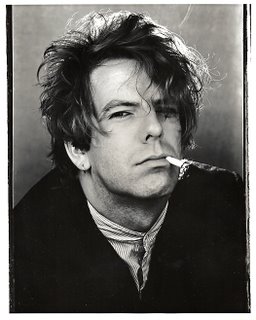
In one occasion that I remember with fondness, I went to see Bergmann at the Town Pump. I was accompanied by a beautiful brunette. The next day I received several phone calls from my friends telling me they had finally caught me cheating on my wife. With glee I had to point out that the brunette was my 20 year-old daugther Ale!
One of my favourite persons at Bergmann concerts was the classy Virginia McKendry. In the late 80s, before smoking became verbotten, watching her smoke her cigarettes, which she held with gloved hands, was magic. I finally went to her house to take her pictures. At the time I was trying to master George Hurrell's glamour lighting. In many respects I didn't rise to the situation and my photographs were not as good as they could have been. I remember that at the time Virginia lived with a beautiful but very sad looking man, Mick Joy who always dressed in black and accompanied Virginia to Bergmann concerts. Virginia was a well read young woman and when I pointed out Gore Vidal's early novel, Messiah she told me, "You can take it home if you want to." I had enjoyed the novel in my youth when Vidal, and Vonnegut were both considered science fiction writers. Messiah is about an undertaker who becomes the messiah helped by the wonders of advertising.
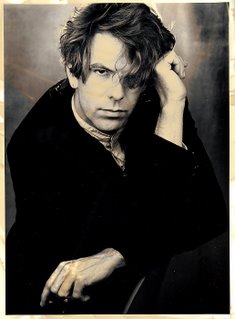
It was published in 1954. One of the protagonists is reading all he can about Julian the Apostate as he plans to write a biography on the man who tried to bring back pagan gods to Christian Rome. In 1964 Vidal wrote a historical novel, Julian.
I have lost track of Virginia but I always remember her when I notice Messiah in one of my bookshelves. My photograph of Art (left) is the image I always have in my head in the last couple of times that I reread Messiah.
Bleeding Heart - Dicentra spectabilis 'Alba'

A Canticle For Leibowitz - Or: How We Learned To Love The Bomb
Sunday, February 04, 2007
My friend Howard Houston in Texas and I have been discussing Edward Rutherfurd's novel Sarum particularly its section on Roman Britain. Howard is most interested in things Roman and in his last communication he wrote:
" One of the things that I found most interesting about Sarum was the tracing of the one family (the first Roman landowners) who managed to stay the leading family in the area for going on a millennia. That a society as advanced as that of the Romans could be brought down to the point that basics like how to make concrete were lost for 1000 years is a warning to us today. "
That set me to thinking about a novel that is one of my favourites and which I first read while boarding at St. Edward’s High School at Austin, Texas. The novel is Walter M. Miller Jr.’s A Canticle For Leibowitz. I read its sequel, Saint Leibowitz And The Wild Horse Woman in 1997 when it came out. At about the same time I read Don DeLillo’s Underworld. Those three books and Howard’s communication have lead to this:
And the story said how Dr. Teller feared the immediate effects of the blast at his viewing site twenty miles from zero point and how he decided it might be helpful to apply sun tan lotion to his face.
--Don De Lillo, Underworld, 1997
“Te absolvat Dominus Jesus Christus: ego autem eius acutoritate te absolve ab omni vinculo…..” before he had finished, a light was shining through the thick curtains of the confessional door. The light grew brighter and brighter until the booth was full of bright noon. The curtain began to smoke.
---Walter M. Miller Jr. , A Canticle for Leibowitz, 1959
Sometime in 1960, in a neo-Gothic chapel at St. Edward’s High School in Austin, Texas (Illustration above by H.N.Pharr II from the inside cover of the 1961 Edwardian), monks of the Catholic Order of the Holy Cross and their wards were chanting the Tantum Ergo. The evening’s benediction was interrupted by air-raid sirens that echoed off the walls and the high ceiling. At Bergstrom, the nearby Strategic Air Command base, B-52D bombers with atom bombs on board took off. We were herded into the basement shelter. Brother Peter Celestine C.S.C. said to us, “Sursum corda; oremus.”
To those of us who lived the day-to-day fear of mass vaporization during the dawn of the Atomic Age and the subsequent Cuban Missile Crisis, the ultimate pean to nuclear destruction was Walter M. Miller Jr.’s A Canticle for Leibowitz. This 1959 science-fiction novel peppered with untranslated Church Latin – about monks who lovingly preserves the remnants of our 20th century civilization, including a delicatessen shopping list by a Jewish nuclear scientist’s wife – has never been out of print. In 1997 Miller’s posthumous Saint Leibowitz and the Wild Horse Woman (Miller committed suicide in 1996) is a sequel of sorts. Both it and Don DeLillo’s Underworld are about Americans coping with nuclear war – in the former, with the actual aftermath of such a war, and in the latter, with the terrible fear of the spectre of such a war created.
Today the fear of A Canticle for Leibowitz ‘s “Flame Deluge”is gone. The Berlin Wall is dust and Mikhail Gorbachev filmed a commercial endorsement for Pizza Hut, before sinking into oblivion. Martin Amis called Underworld “Don DeLillo’s wake for the cold war.” Now that Bacillus anthracis is our weapon of mass destruction of choice, some of us might find an odd comfort in the familiarity of the nuclear blast and its fallout. But it all seems like many lifetimes ago, now. I would not be surprised if any contemporary reader of Underworld might not understand a number of DeLillo’s Cold War references, such as, “He stood looking at the strontium white loaf that sat on a bed of lettuce inside a cake pan in the middle of the table.”
For those like myself who have been rereading A Canticle every few years its sequel (not really a sequel, as it fits in between Canticle’s Chapter 1, “Fiat Homo”, and Chapter 3, “Fiat Voluntas Tua”) and DeLillo’s Underworld brings more of that comforting, familiar stuff. It’s kind of like seeing the Beatles on The Ed Sullivan Show again. But just as we cannot ignore the Dakota, we can’t read DeLillo’s “Clyde Tolson, known as Junior, was Edgar’s staunchest aide in the Bureau [FBI] his dearest friend and inseparable companion” without knowing what’s coming. And that is the loss of innocence – the end of an era when G-men, the good guys battled crime, and criminals who had a face. Underworld is about what happened to Americans when the Russians exploded their own bomb and how the wonder of Kelvinators, Cinemascope movies, and Ford-O–Matic drive could not take away the fear of an unknown, the static beeping fo that Russian grapefruit, Sputnik. Underworld is more thematically fuelled than plot-driven, and it is populated by myriad characters. There is no single protagonist, except, perhaps a baseball that changes hands several times over the course of the novel’s four decades.
In Saint Leibowitz and the Wild Horse Woman, Miller plunks us down in a 32nd century post American Southwest where remnants of a previous post nuclear civilization, now horse-bound like Plains Indians, fight off the tightening control of the West by the Misery River Texark Empire while embroiled in numerous papal conclaves. We get to meet all kinds of unlikely popes, who die off with more regularity than victims in a serial-murder novel, while realizing that this future, with its papal schisms, interdicts, and marauding warlords, is no different from our own Avignon past. The Borgias would have relished this book.
Saint Leibowitz gives us delicious glimpses of what might happen in the future, such as the rediscovery of “electrical essence” and its first use (by means of a people-driven dynamo), not for lighting, but for the dispatching of criminals in an electric chair. There is an interesting parallel in Underworld. During the 70s, in a scary Bronx neighbourhood that could be a Leibowitzian ground-zero (when that word meant something that it no longer means to those who have lived 9-11), I read about a little kid seated on a stationary bike and pedaling frantically – but not for exercise. The bike is linked to a Second World War generator, and “there are cables running from the unit up to the TV and there is a wheezing drive belt connecting the the generator to the bicycle… the generator ekes out a flow of electricity to the television set – a brave beat-up model that two other kids dug out fo the garbage pits, where it was layered in the geological age of leisure-time appliances.”
Both books are complex reads and backwards page-turners. You come upon sentences with a sense of déja vu, knowing you have already read them somewhere in an earlier chapter. Each novel makes good use of repetition techniques. Miller uses the recurring themes of buzzards and a seemingly immortal wandering Jew. In Underworld, some of the sentences and paragraphs reminded me of composer Steve Reich’s 1975 composition Six Pianos –deceptively simple and repetitive music that evolves into a mesmerizing pattern. DeLillo also manipulates time. He writes as if he were working with electronic hypertext rather than words fixed on paper. And he brings to his novel such apparently unrelated topics as garbage, B-52 bombers in the desert, a single famous baseball, a martinet nun, and Lenny Bruce. Only at the end do all of the links become manifest.
Miller, a decorated Second World War hero, was a gunner in the bombing of the Benedictine monastery in Monte Cassino. Fittingly each chapter of Saint Leibovitz begins with one of Saint Benedict’s rules for monasteries. Chapter 20 begins, “We think it sufficient for the daily dinner, whether at the sixth or ninth hour, that every table have two cooked dishes, on account of individual infirmities, so that he who for some reason cannot eat of the one may make his meal of the other.” DeLillo’s Underworld is certainly fitting but in Saint Leibowitz and the Wild Horse Woman I don’t see anything but a splendid dessert. That two course meal would have to include A Canticle For Leibowitz.
And Howard, if you happen to read this, none of the above mention Roman concrete.
Edith Iglauer & Valerie Gibson
Saturday, February 03, 2007
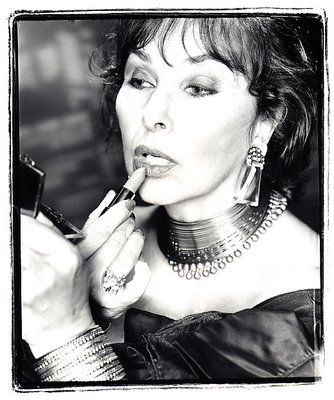 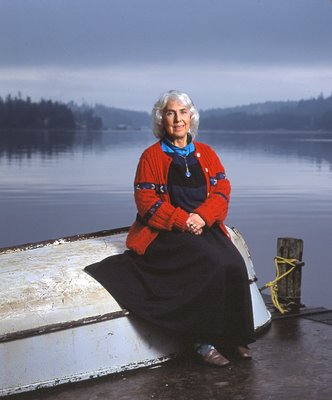 In 1981 American writer Edith Iglauer wrote Seven Stones - A Portrait Of Arthur Erickson - Architect. Not known by many is that Vancouver Magazine gossip writer Valerie Gibson had helped Iglauer in her research for the book. At the time Gibson knew more about most of the people in power in Canada, BC and Vancouver than anybody. And Vancouver Magazine editor Malcolm Parry knew this. So Gibson wrote a monthly column that was the most popular column in any magazine in our city at the time. Mac knew that she had other talents and it was her 1978 cover article on 6 very old and brilliant Vancouver old timers (including Jessie Richardson) that was my first magazine cover. For many years she insisted that I take the pictures for her column, as she explained to Mac, "Alex knows who my people are and I don't have to tell him whom to photograph." It was amazing to see Gibson work a room. She would occasionally whisper in my ear, "My! That's the third time Elini Skalbania has worn that dress!" In 1987 I went to the Sunshine Coast to photograph Edith Iglauer at her home. I was particularly excited as I had read and thoroughly enjoyed (even though I hate fishing, fish and I get seasick on any boat) her book and part memoir, Fishing With John. It was there that I also first met her son Jay, by a previous marriage to Philip Hamburger of The New Yorker fame. I don't think anybody else would have been so gracious and delighted as she was when I gave her as a gift (I was told that she was going to insist I stay for dinner) a large tin of Russian Caravan tea. The meal was one of the best I have ever had in my life. At dinner she told me that Valerie Gibson had a special gift for writing and she only wished she (Iglauer) could push Gibson to take her seriously and write. I have not seen Gibson for at least 8 years and I last saw Iglauer and Jay a couple of years ago at a party at Arthur Erickson's garden. Every once in a while (it is usually a Japanese restaurant or a theatre) that I delight in being able to loudly yell, "Hey, Hamburger!" and Jay comes over to where I am and he updates me on the status of his mother and the state of his plays. He is a playwright. Today editor/art director Bob Mercer told me that during his short tenure as editor of Vancouver Magazine, Valerie Gibson won the magazine an award for a profile on John Turner.
Pancho El Esqueleto
Friday, February 02, 2007
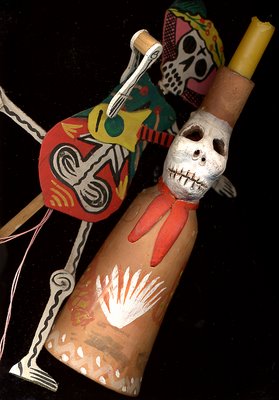 I saw this forlorn guy (he is both a candle stick and a bell) at a Comercial Mexicana near our home in the Estado de Mexico (outside Mexico City) 34 years ago. The company, which had a chain of large Save on Foods type stores in central Mexico was owned by the gracious, beautiful and very Spanish Mrs. Gonzalez. I had recently taken her family photographs. Rosemary and I liked her stores because she also sold fine Mexican crafts. I had spotted this 10-inch-long guy many times but nobody had bought him. Someone had written in bold black marker Pancho El Esqueleto (Pancho the skeleton) at the bottom. I felt so sorry for him that I finally brought him home. He has been part of our family all these years and all that remains of the graffiti is that black sweap at the bottom. Inside the bell his maker signed Josefina Aguilar. While there is no connection between death and Christmas we light the candle on Christmas Eve and Pancho shares space at our Christmas Eve dinner table. Rebecca is always scoffing at me for saying stuff, "When I am dead, Rebecca...." She is beginning to understand me. After all we had a great time looking at every momia (mummy) in Guanajuato. They are frozen in death with horrible expressions on their faces. She is still suitably impressed by the final scene in Navigator - A Mediaeval Odyssey we saw a few weeks back. The little boy's coffin is gently pushed into the sea at the end. I think it is important to recognize the existence of death at a young age. When I was 11, or two years older than Rebecca the big orange Colegio Americano bus picked me up at my house in Mexico City. On its way to the school in Tacubaya I always anticipated as it passed by the Panteón Dolores which is a huge old cemetery in Mexico City. The long walls, all in the shade of the thick growth of trees, were full of moss. I could see the statues and crosses of the grave monuments peeking over the wall at me. I was never curious enough to visit. And of course, if I had my chance, I would go back to Mexico City just to "do" the Panteón with my cameras.
1/5 Of The Perfect Breakfast
Thursday, February 01, 2007
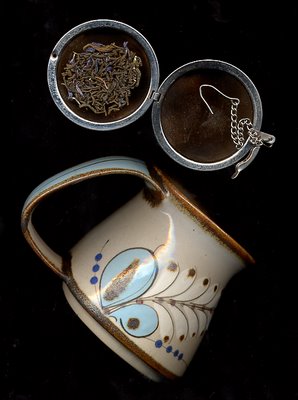
Since I can remember I have enjoyed tea. By tea I mean the stuff that Yankee Clipper ships carried while braving storms around Cape Horn, racing to get it home first from the Orient, to fetch the best price. I mean the kind that comes from fermented leaves of Camellia sinensis . I am very subjective about tea. I think Japanese maccha (matcha) is glorified swamp water, no matter how many oxidants it may have. I will drink Japanese tea, so similar to celery broth, only with Japanese food. I love the taste of tea sweetened with a sweetener (white sugar) that does not add any taste. And, like Dr. Samuel Johnson I put enough milk (very little) to allay the bite of the tannin. My tea has to be the colour of Coke so I use two heaping spoonfulls in the teaball seen here which I steep for at least 5 minutes in my Ken Edwards mug from Tonalá, Mexico.
In Argentina I tolerated the excellent Taragüí that is grown in Corrientes province. In our years in Mexico (the importation of tea was prohibited) we treasured and re-used smuggled American Lipton Tea bags. The worst tea I ever had was at the fashionable Kinneret Café at the Zona Rosa. I asked for a té con leche . I was served a cup of boiling milk with a tea bag. When we moved to Vancouver I swore I would always drink the best tea.
I purchase my favourite tea (with the exception of the wonderfully strong Taylors of Harrogate Yorkshire Gold at the Gourmet Warehouse) at the Granville Island Tea Company. They sell the perfect, strongest and most fragrant Earl Grey. If you look closely at the above image you will note the blue filaments and flower buds. Since I am supposed to know so much about tea I have been ashamed to ask them what they are! Their Organic Assam and their Rwanda Rukeri are equally strong.
On my two visits to London what I missed most about Vancouver was a decent cup of tea. Unless a hotel used bottled water (they didn't) London tea is made with some swill the English call water. Their tea is terrible. But it was in London where I purchased one pound of Saint James Fannings for £85. I nursed that tea for six months back in Vancouver and this was the most complicated, interesting and flavourful tea I have ever had. In the best book about tea ( alas! a French book called The Book of Tea) this is what it says of Saint James Fannings:
Paris
Betjeman And Barton
23 Boulevard Malesherbes
75008 Paris
This shop is regularly visited by tea lovers. Every day, a cup of one of the hundred and twenty teas stored in either red or green canisters is offered to customers - with any luck you may drop in on a day when a Saint James Fannings or a Castleton G.E.O.P. second flush is being brewed.
But tea is only 1/5 of my perfect breakfast. For 12 years Rosemary (2/5) and I have had our breakfast in bed (3/5) every day of the week. In leaner times we used to celebrate Sundays with bacon. But that is no more. Our perfect breakfast is her coffee, my tea, her toast with honey, my (two) Venice Bakery Brown & Serve Original Scissors (4/5), and a copy of our daily delivered New York Times (5/5).
Modern technology has changed the routine a bit. Since I read the Sunday New York Times at 10pm on Saturday, when it is delivered, Sunday is back to 4/5 perfection. It becomes 3/5 when our grandaughters have a sleepover (four for breakfast in bed was much too messy). But sitting at the table on Sunday with Lauren and Rebecca is 4/5 again and with the thin homemade pancakes it's a perfect breakfast again! Unsalted cultured butter and confectionary sugar on pancakes accompanied by an Earl Grey is as perfect as perfect is.
Granville Island Routine
|






















